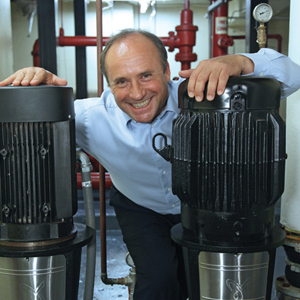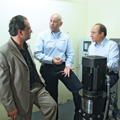Advanced pumping system dramatically lowers New Jersey building’s energy costs. Evan Samouhos was so confident in the potential energy savings offered by a new domestic water booster pump system that he fronted the purchase himself.

Evan Samouhos was so confident in the potential energy savings offered by a new domestic water booster pump system that he fronted the purchase himself.
“We had absolutely no doubt that we could slash half of the operating costs of a commercial domestic water-boosting application by using intelligent, demand-based pump technology,” recalls Samouhos, president of West Orange, N.J.-based Evco Mechanical, and a 32-year plumbing industry veteran.
“The problem, however, was convincing a price-conscious customer to invest in new technology instead of rebuilding the decades-old pressure-boosting pumps and motor drives.”
The application supported the domestic water delivery system for half of the Parkview Towers, a 684-unit affordable housing complex in West New York, N.J. Built in 1974 and located blocks from the Hudson River, the pumping station delivers domestic water to one of the twin 24-story apartment building towers.
“In recent years, variable-frequency drive technology has become more affordable and critical in bringing intelligent speed control to a number of commercial pumping applications, including domestic water boosting,” explains Peter Frangiskou, P.E., vice president of Dolphin Equipment Corp., an independent manufacturers agent based in Haworth, N.J. “The ability to scale output based on demand was the primary reason we knew we could significantly reduce energy consumption for this building.”
Convincing the end-user was not as clear-cut, however.
“We were initially skeptical of the recommendation to completely replace the system because it was still viable,” property manager Blanca Alvarez recalls. “It’s hard to justify capital investments, especially in this economy, for equipment that is operating as designed.”
Samouhos, who enjoys a long-working relationship with building management, personally guaranteed a significant energy savings with the new system, a Grundfos BoosterpaQ Pressure Boosting Station.
“I told the building owner, if the new boosters didn’t reduce energy consumption by 40% to 50%, they didn’t have to pay me a dime,” says Samouhos, who concedes he had achieved similar head-turning results since he began using the preconfigured boosting stations in 2007.
In the end, an independent project audit vindicated the daring claim by documenting a 90% energy savings over a one-week period in September 2010 and a 26-month payback period. The audit not only justified Samouhos’ recommendation, but helped cement a valuable business relationship between himself and Parkview Towers management.

Control the flow
Demand for water in multistory buildings, such as Parkview Towers, can vary significantly throughout the day. This unpredictable flow places extraordinary demands on pumping equipment. High-rise buildings – including hotel, multifamily, office and other institutional applications – require pressure-boosting equipment to raise incoming municipal water pressure to serve the top floors.
Samouhos recommended replacing the single building’s existing water pressure-boosting system to overcome two system shortcomings: the frequent malfunction of mechanical pressure-regulating valves that were prone to clogging and the inability to match pump/motor output with flow demand.
He turned to Dolphin Equipment to help identify an option that would efficiently meet system demand.
“We wanted an affordable, high-performance packaged replacement that could deliver up to 200 psi, while still being compact in size,” explains Andrew Cirillo, Dolphin’s sales engineer. “While several boosting stations offer energy efficiencies and sophisticated controllers, only this multi-stage pump system was capable of meeting our pressure rating requirements right out of the box, with no additional components to buy.”
While pressure-regulating valves are widely used to control discharge pressure to a water distribution system, such as Parkview Towers, they also are susceptible to debris buildup and require periodic adjustment and maintenance. Moreover, fixed-speed pumps operating with pressure-regulating valves run at full speed when flow requirements are low, a condition that can cause pump wear, seal damage and wasted energy.
The water delivery system surrounding Parkview Towers was frequently marred by mineral and scale deposits, possibly shaken loose with the opening of a fire main or other large system shocks. This debris would decrease the efficiency of the valves and result in large pressure fluctuations that could damage plumbing fixture fittings, including water closets, faucets, relief valves, shock absorbers and expansion joints, as well as result in plumbing pipe leaks.

Beyond the clogging and frequent loss of pressure control, the existing water distribution system provided a constant output and continual energy consumption, regardless of demand. Even during low water usage times, such as overnight periods, the practice was to continuously operate the pumps. That not only wastes electricity, but it also decreases the life expectancy of the equipment.
Matching output with demand
Based on these two performance concerns, Samouhos installed the Grundfos integrated pressure-boosting system that offers up to six vertical multistage CR pumps in parallel operation, designed to optimize pumping efficiency over a range of flow rates. Ideal for water supply systems as well as industrial and irrigation applications, the system utilizes an advanced controller that along with variable-frequency drive-controlled motors, adjusts pump speed and the number of pumps in operation to meet frequently changing system demand.
Instead of using constant-speed pumps regulated by maintenance-prone pressure- reducing valves, the new system delivers the minimal pump output necessary to achieve optimal performance - all without direct human intervention.
“Rather than running flat-out, at top horsepower and bleeding off excess pressure to reach the desired output, the more energy-efficient option is to design a system that starts from zero and ramps up to meet the specific demand,” Cirillo explains. “Since demand is not a constant, why not vary output?”

Proof in numbers
The tower’s original pressure-boosting system utilized three constant-speed pumps: two 40-horespower pumps and a 20-horsepower backup pump. With no pump sequencing software in place, the two primary 40-horsepower pumps operated continuously unless alternated manually by the building engineer during periods of low demand. The new boosting station leveraged two 15-horsepower pumps with variable-frequency drive-controlled motors. A single 15-horsepower pump handles the tower’s full pressure load. But if demand exceeds this capacity, the second pump will provide additional pressure. In addition to matching pump output to flow demand, the new duplex boosting station yields significant energy savings.
“In calculating the flow rate requirements for the building, we determined that we could not only eliminate an entire pump, but also downsize the remaining two – from 100 total horsepower to 30 horsepower, without sacrificing performance,” Samouhos reports. “Despite removing 70 horsepower from this system, the computerized control, demand-based performance of the new pumping station averages just 30% capacity.”
Nonetheless, upon seeing the reduced specifications, building management doubted the system could perform as designed.
“Building engineers were concerned the system was undersized and would not deliver adequate pressure to the upper floors,” Alvarez recalls. “Saving energy was important, but system performance was paramount.”
To illustrate the savings of moving from a constant-speed pump to a variable, demand-based platform, Dolphin Equipment commissioned an energy audit of both apartment towers. The audit compared the power used by the duplex boosting station against the conventional triplex system installed in the companion building.
“We thought, ‘Where else will you come across two identical-use buildings – one with energy-efficient technology and the other without?’” Frangiskou says. “This was the perfect application to showcase the operating and energy efficiencies of demand-based technology.”
The audit, paid for by Grundfos and Dolphin Equipment, bore out Samouhos’ original intuition and helped to justify his replacement vs. repair recommendation.

“We monitored the three-phase electrical consumption of the pressure-boosting equipment in both apartment towers over a one-week period to account for changes in load demands,” states Tony Sinacore, an applications engineer with Ramsey, N.J.-based energy audit firm SDM Metro.
“Our team recorded a 92% drop in power consumption in the building that was fitted with the energy-efficient boosting station over the conventional system installed in the building’s other tower.”
Sinacore notes the energy used during this one-week period would yield 121,067 kilowatt-hours annually, or an annual utility cost reduction of nearly $18,160, based on an average area utility rate of $0.15 per kilowatt-hour (see chart above).
Sinacore estimates the total project savings over a 15-year average pump lifespan at just under $275,000. The level of savings, in fact, was so dramatic that similar variable-speed drives were installed in the companion tower to begin matching pump output with demand.
According to Grundfos, power consumption accounts for 85% of all costs incurred during the life cycle of a pump. The initial pump purchase price and the cost of regular maintenance account for the remainder. Therefore, even the smallest improvement in energy efficiency can translate to sizeable savings. In addition, system designers can squeeze an additional 10% to 35% in energy savings by transitioning from pumps that use pressure- reducing valves to those that leverage variable-speed drives, depending on the system parameters.
“Building management was stunned that we could deliver the same level of performance using just one-third the pumping horsepower of the old system,” Samouhos says. “Every day the engineers would come in to see if the system was collapsing under the crushing demand, only to find the booster station barely breaking a sweat.”
